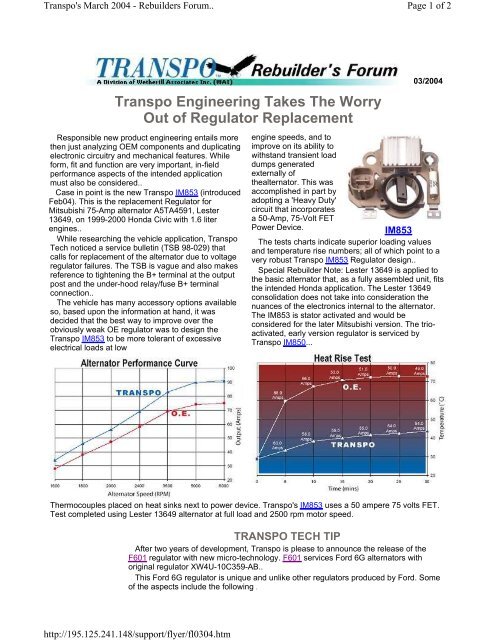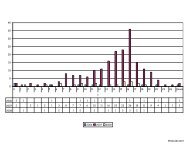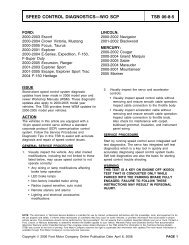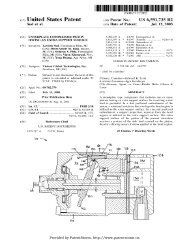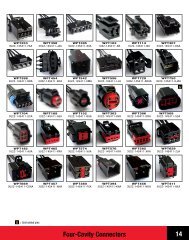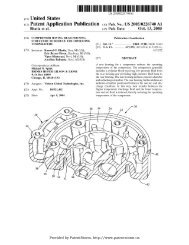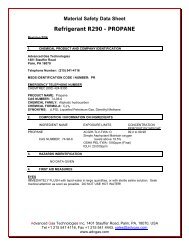Transpo Engineering Takes The Worry Out of Regulator ... - IDMsvcs
Transpo Engineering Takes The Worry Out of Regulator ... - IDMsvcs
Transpo Engineering Takes The Worry Out of Regulator ... - IDMsvcs
Create successful ePaper yourself
Turn your PDF publications into a flip-book with our unique Google optimized e-Paper software.
<strong>Transpo</strong>'s March 2004 - Rebuilders Forum..<br />
http://195.125.241.148/support/flyer/fl0304.htm<br />
Page 1 <strong>of</strong> 2<br />
<strong>Transpo</strong> <strong>Engineering</strong> <strong>Takes</strong> <strong>The</strong> <strong>Worry</strong><br />
<strong>Out</strong> <strong>of</strong> <strong>Regulator</strong> Replacement<br />
Responsible new product engineering entails more<br />
then just analyzing OEM components and duplicating<br />
electronic circuitry and mechanical features. While<br />
form, fit and function are very important, in-field<br />
performance aspects <strong>of</strong> the intended application<br />
must also be considered..<br />
Case in point is the new <strong>Transpo</strong> IM853 (introduced<br />
Feb04). This is the replacement <strong>Regulator</strong> for<br />
Mitsubishi 75-Amp alternator A5TA4591, Lester<br />
13649, on 1999-2000 Honda Civic with 1.6 liter<br />
engines..<br />
While researching the vehicle application, <strong>Transpo</strong><br />
Tech noticed a service bulletin (TSB 98-029) that<br />
calls for replacement <strong>of</strong> the alternator due to voltage<br />
regulator failures. <strong>The</strong> TSB is vague and also makes<br />
reference to tightening the B+ terminal at the output<br />
post and the under-hood relay/fuse B+ terminal<br />
connection..<br />
<strong>The</strong> vehicle has many accessory options available<br />
so, based upon the information at hand, it was<br />
decided that the best way to improve over the<br />
obviously weak OE regulator was to design the<br />
<strong>Transpo</strong> IM853 to be more tolerant <strong>of</strong> excessive<br />
electrical loads at low<br />
03/2004<br />
engine speeds, and to<br />
improve on its ability to<br />
withstand transient load<br />
dumps generated<br />
externally <strong>of</strong><br />
thealternator. This was<br />
accomplished in part by<br />
adopting a 'Heavy Duty'<br />
circuit that incorporates<br />
a 50-Amp, 75-Volt FET<br />
Power Device.<br />
IM853<br />
<strong>The</strong> tests charts indicate superior loading values<br />
and temperature rise numbers; all <strong>of</strong> which point to a<br />
very robust <strong>Transpo</strong> IM853 <strong>Regulator</strong> design..<br />
Special Rebuilder Note: Lester 13649 is applied to<br />
the basic alternator that, as a fully assembled unit, fits<br />
the intended Honda application. <strong>The</strong> Lester 13649<br />
consolidation does not take into consideration the<br />
nuances <strong>of</strong> the electronics internal to the alternator.<br />
<strong>The</strong> IM853 is stator activated and would be<br />
considered for the later Mitsubishi version. <strong>The</strong> trioactivated,<br />
early version regulator is serviced by<br />
<strong>Transpo</strong> IM850...<br />
<strong>The</strong>rmocouples placed on heat sinks next to power device. <strong>Transpo</strong>'s IM853 uses a 50 ampere 75 volts FET.<br />
Test completed using Lester 13649 alternator at full load and 2500 rpm motor speed.<br />
TRANSPO TECH TIP<br />
After two years <strong>of</strong> development, <strong>Transpo</strong> is please to announce the release <strong>of</strong> the<br />
F601 regulator with new micro-technology. F601 services Ford 6G alternators with<br />
original regulator XW4U-10C359-AB..<br />
This Ford 6G regulator is unique and unlike other regulators produced by Ford. Some<br />
<strong>of</strong> the aspects include the following .
<strong>Transpo</strong>'s March 2004 - Rebuilders Forum..<br />
http://195.125.241.148/support/flyer/fl0304.htm<br />
Page 2 <strong>of</strong> 2<br />
• LI terminal, also known as feedback (FR). • RC terminal, also known as signal (SIG) •<br />
S .<br />
terminal, also known as B+ or sense (S, As). • No Lamp-Circuit function, Lamp is 100% controlled by the<br />
vehicle PCM. • <strong>Regulator</strong> Set Point range is 12.5 Volts to 16.0 Volts and is determined by the PCM signal.<br />
<strong>The</strong> PCM control signal that is sent to the regulator (via the vehicle PCM signal line) is a variable pulse-width<br />
modulated signal provided at a fixed 125 Hertz frequency. As an example, a 55% PWM signal from the PCM<br />
yields a regulation voltage <strong>of</strong> 14.25V (+/- 0.1)..<br />
Considering the intricacies <strong>of</strong> the design, and that full regulator function is dependent upon the vehicle<br />
computer interface, existing bench testing methods will no longer tell the full story.<br />
Without a custom test adapter with signal interface, only default voltage tests may be performed. A default<br />
voltage test will indicate that the regulator is basically functional but it will not answer the question <strong>of</strong> whether<br />
the regulator circuit will change the set point according to PCM commands, or whether feed-back from the<br />
regulator circuit is working or accurate .<br />
To load test an alternator using regulator default voltages, connect power-source B+ to the alternator output<br />
terminal as usual, then ground the regulator 'RC' pin (center-pin). Test voltage will read approximately 13.9<br />
Volts. Connecting power-source B+ to the 'S' pin in addition to grounding the 'RC' should yield a reading <strong>of</strong><br />
approximately 13.7 Volts. Alternator test output may be something less than the alternator's rated output, due<br />
to these lower voltages..<br />
It should be noted that the <strong>Transpo</strong> F601 design <strong>of</strong>fers an added 'efficiency' feature referred to as 'Burst<br />
Mode'. This function serves to maintain the voltage set point last directed by the PCM, rather than requiring<br />
continuous PCM adjustment to maintain the set point..<br />
Thank You For Your Business!


